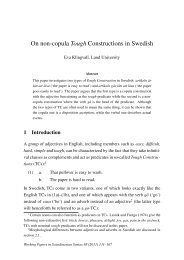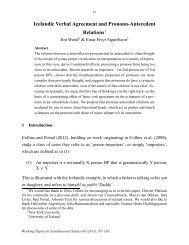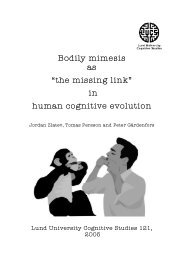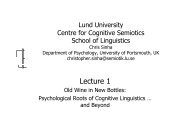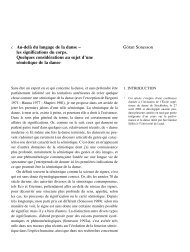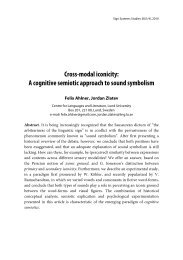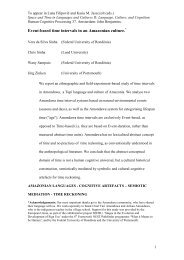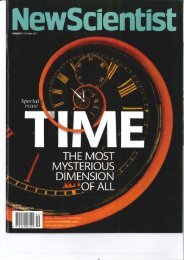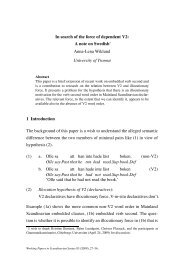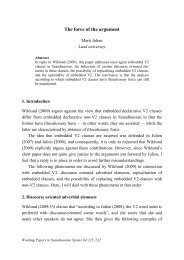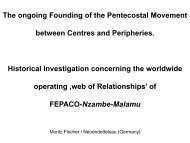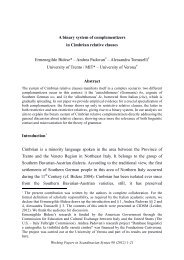ELLERHUR and other Yes/No-question operator ... - Lunds universitet
ELLERHUR and other Yes/No-question operator ... - Lunds universitet
ELLERHUR and other Yes/No-question operator ... - Lunds universitet
Create successful ePaper yourself
Turn your PDF publications into a flip-book with our unique Google optimized e-Paper software.
<strong>ELLERHUR</strong> <strong>and</strong> <strong>other</strong> <strong>Yes</strong>/<strong>No</strong>-<strong>question</strong> <strong>operator</strong><br />
c<strong>and</strong>idates in Swedish *<br />
David Petersson, Lund University<br />
Gunlög Josefsson, Lund University<br />
Abstract. Our point of departure is a new use of the <strong>question</strong> tag eller hur (or how) „isn‟t it‟ in<br />
Swedish:<br />
(i) Eller hur ska vi åka till Italien i sommar<br />
or how shall we go to Italy in summer<br />
„We will go to Italy this summer,. won‟t we‟<br />
We argue that eller hur used in this way is an overt <strong>Yes</strong>/<strong>No</strong>-<strong>question</strong> <strong>operator</strong>, <strong>and</strong> that it patterns<br />
with visst <strong>and</strong> nog, which we propose are two <strong>other</strong> <strong>Yes</strong>/<strong>No</strong>-<strong>question</strong> <strong>operator</strong>s in Swedish.<br />
We also discuss eller hur that combines with a that-clause, a configuration that yields a<br />
sentence that in most cases is construed as an ironic statement. We argue that this instance of eller<br />
hur is not a <strong>question</strong> <strong>operator</strong>, but what we term a non-verbal matrix, <strong>and</strong> furthermore that eller<br />
hur, followed by a that-clause, patterns with <strong>other</strong> non-verbal matrices with a similar meaning,<br />
such as visst „sure‟ <strong>and</strong> säkert „sure‟.<br />
1 Introduction<br />
The default <strong>question</strong> tag in Swedish is eller hur (or how). Just like its English<br />
counterpart isn’t it, eller hur is used in contexts where the speaker expects the<br />
listener to agree with the statement just made. Consider (1) for an example:<br />
(1) Filmen var bra, eller hur<br />
film.the was good, or how<br />
‟The film was good, wasn‟t it”<br />
* This paper has been presented at the Grammar Seminar, Centre for Languages <strong>and</strong> Literature,<br />
Lund University. We thank the participants at this seminar for valuable comments <strong>and</strong> criticism.<br />
A special thanks goes to Valeria Molnár <strong>and</strong> Christer Platzack for valuable comments.<br />
Working Papers in Sc<strong>and</strong>inavian Syntax 86 (2010) 179–198.
180<br />
A new way of using eller hur has developed, especially among children <strong>and</strong><br />
youngsters. Eller hur can nowadays be used in a clause initial position, which is<br />
illustrated in (2). In what follows we will annotate eller hur in its new use as<br />
<strong>ELLERHUR</strong>.<br />
(2) <strong>ELLERHUR</strong> var filmen bra<br />
<strong>ELLERHUR</strong> was film.the good<br />
„The film was good, wasn‟t it‟<br />
As (2) shows, <strong>ELLERHUR</strong> precedes the finite verb, which indicates that it is a fully<br />
integrated part of the clause; hence we gather that its syntactic status differs from<br />
eller hur in examples such as (1); as a tag <strong>question</strong> eller hur is most reasonably<br />
right dislocated. 1<br />
In its new use, <strong>ELLERHUR</strong> may also precede a that-clause.<br />
(3) <strong>ELLERHUR</strong> att filmen var bra.<br />
<strong>ELLERHUR</strong> that film.the was good<br />
As will be elaborated in more detail in section 3, the meaning of sentences such as<br />
(3) depends on the context; typically the sentences convey an ironic meaning. 2<br />
Our paper has several purposes: Y/N-<strong>question</strong> <strong>operator</strong>s in Swedish is the topic<br />
of section 2. First of all we present an analysis of the new <strong>ELLERHUR</strong> + finite<br />
verb. In short, we argue that <strong>ELLERHUR</strong> in examples such as (2) is a Y/N-<strong>question</strong><br />
1 We take no definite st<strong>and</strong> as how to right dislocation should be analysed syntactically, but<br />
assume that right dislocated elements are located in a separate syntactic domain, associated<br />
with the preceding clause semantically.<br />
2 Yet an<strong>other</strong> recently developed use of <strong>ELLERHUR</strong> should be mentioned. Consider (i).<br />
(i) A: Svenskläraren är typ jordens tråkigaste människa.<br />
Swedish teacher.the is like earth.the’s most.boring person<br />
'The Swedish teacher is like the most boring person on earth'<br />
B: Eller hur!<br />
or how<br />
'I agree!'<br />
In the example above, <strong>ELLERHUR</strong> is used as an answer. By uttering <strong>ELLERHUR</strong>, speaker B<br />
signals that he or she agrees with the statement made by speaker A. There is most probably a<br />
connection between all the new uses of <strong>ELLERHUR</strong>, but the nature of this relation will not<br />
be explored in this paper.
181<br />
<strong>operator</strong>. Secondly, we argue that Swedish has more Y/N-<strong>question</strong> <strong>operator</strong>s, in<br />
particular visst <strong>and</strong> nog, <strong>and</strong> that <strong>ELLERHUR</strong> patterns with these <strong>operator</strong>s. In<br />
section 3 we argue that <strong>ELLERHUR</strong> immediately preceding a that-clause, as in (3),<br />
is an example of what we call a non-verbal matrix. In this latter use <strong>ELLERHUR</strong><br />
does not have any <strong>question</strong> <strong>operator</strong> properties. Section 4 contains a short<br />
summary.<br />
2 Y/N-<strong>question</strong> <strong>operator</strong>s in Swedish<br />
2.1 <strong>ELLERHUR</strong> in V2-constructions, a recently emerged Y/N<strong>question</strong><br />
<strong>operator</strong><br />
As pointed out in the introduction, <strong>ELLERHUR</strong> in its new use may precede the<br />
finite verb in main clauses. Consider (4), which is a repetition of (2) above.<br />
(4) <strong>ELLERHUR</strong> var filmen bra<br />
<strong>ELLERHUR</strong> was film.the good<br />
„The film was good, wasn‟t it‟<br />
The fact that <strong>ELLERHUR</strong> in (4) triggers V2 shows beyond doubt that it is an<br />
integrated part of the clause, on a par with fronted objects or adverbials, elements<br />
that all trigger V2. Compare (4) to the examples in (5).<br />
(5) a Filmen tänkte vi se.<br />
film.the thought we see<br />
‟We planned to see the film.‟<br />
b Idag tänkte vi se film.<br />
today thought we see film<br />
‟We planned to see a film today.‟<br />
c Förmodligen tänker de se film.<br />
probably think they see film<br />
‟They‟ll probably see a film.‟
182<br />
We assume that tag <strong>question</strong>s, such as isn’t it in English <strong>and</strong> eller hur in Swedish,<br />
are not integrated syntactically into the preceding “host clause”. Thus, a sentence<br />
such as (1) consists of a statement, Filmen var bra ‟The film was good‟, followed<br />
by a <strong>question</strong> with the intended meaning ‟Don‟t you agree that the film was good‟.<br />
The two syntactic constituents make up one utterance. The function of a tag<br />
<strong>question</strong> is to ask the listener for support. This is also the meaning that <strong>ELLERHUR</strong><br />
in its new sentence initial position conveys. What is important is that <strong>ELLERHUR</strong><br />
is an integrated part of the clause. There is thus just one single CP in (4), a Y/N<strong>question</strong>,<br />
<strong>and</strong> the clause-initial element, <strong>ELLERHUR</strong>, is what makes the constituent<br />
a <strong>question</strong>.<br />
The expected answer to (4) is ”<strong>Yes</strong>, it was.”, ”<strong>Yes</strong>, the film was fantastic” or<br />
alike. The fact that <strong>ELLERHUR</strong> turns the sentence into a Y/N-<strong>question</strong> suggests<br />
that <strong>ELLERHUR</strong> in a clause initial position is a <strong>question</strong> <strong>operator</strong>, more specifically<br />
an overt instance of the null <strong>question</strong> <strong>operator</strong> Q that Katz & Postal (1964) have<br />
postulated for English. 3 This conclusion might come as somewhat surprising; to the<br />
best of our knowledge overt Y/N-<strong>question</strong> <strong>operator</strong>s have not been suggested for<br />
Swedish previously. However, such <strong>operator</strong>s are quite frequent in <strong>other</strong> languages.<br />
For instance, Platzack (2010: 58) argues that Old Icel<strong>and</strong>ic hvart is an <strong>operator</strong> of<br />
this kind, see (6a), <strong>and</strong> Radford (1988:296) shows that Y/N-<strong>question</strong> <strong>operator</strong>s are<br />
found in Yiddish, Polish, Estonian, see (6b–d):<br />
(6) a Hvart má G. heyra mál mitt (Old Icel<strong>and</strong>ic)<br />
OP may G. hear speech my<br />
‟May G hear my speech now‟<br />
b Tsi hot er geleient dos bux (Yiddish)<br />
OP has he read DET book<br />
‟Has he read the book.‟<br />
c Czy zamykacie okna (Polish)<br />
OP you.close windows<br />
‟Do you close the windows‟<br />
3 The idea that Swedish has null <strong>Yes</strong>/<strong>No</strong>-<strong>question</strong> <strong>operator</strong>s of the type assumed for English are<br />
discussed for instance in Platzack (1998) <strong>and</strong> (2010), as well as in Waldmann (2008, 39).
183<br />
d Kas suitsetate<br />
OP you.smoke<br />
‟Do you smoke‟<br />
(Estonian)<br />
e Tsi hot er geleient dos bux (Yiddish)<br />
OP has he read DET book<br />
‟Has he read the book.‟<br />
Other languages with overt Y/N-<strong>question</strong>s <strong>operator</strong>s are Bulgarian <strong>and</strong> Japanese<br />
(see Platzack 2010, 58). Also Latin appears to have overt Y/N-<strong>question</strong> <strong>operator</strong>s.<br />
Consider (7), which shows examples with -ne, nonne, <strong>and</strong> num.<br />
(7) a Vides-ne<br />
See.you-OP<br />
‟Do you see‟<br />
b <strong>No</strong>nne vides<br />
OP see.you<br />
‟Don‟t you see‟<br />
c Num vides<br />
OP see.you<br />
‟Do you really see‟<br />
The particle nonne seems to be the negative correspondent to -ne; it conveys an<br />
expectation for a negative answer, whereas -ne conveys an expectation for a<br />
positive answer. However, the Latin <strong>question</strong> particle that seems to correspond<br />
most closely to <strong>ELLERHUR</strong> is an:<br />
(8) Hostes facile vincemus. An non pares iis sumus<br />
Enemies easily overcome.2PL OP not equal to.them be.2PL<br />
„We shall beat the enemies easily. Or, aren‟t we equally good‟<br />
The particle an, in our view a Y/N-<strong>question</strong> <strong>operator</strong>, conveys a strong expectation<br />
for a positive answer.<br />
The examples in (6)–(8) show that overt Y/N-<strong>question</strong> <strong>operator</strong>s are found in<br />
closely as well as not so closely related languages; hence it not so strange that we<br />
find them in Swedish too.
184<br />
2.2 Other Y/N- <strong>question</strong> <strong>operator</strong> c<strong>and</strong>idates in Swedish<br />
An interesting <strong>question</strong> is why <strong>ELLERHUR</strong> has become a Y/N-<strong>question</strong> <strong>operator</strong> in<br />
Swedish – as pointed out above this seems to be a fairly recent development. A clue<br />
to an answer is suggested in an article by the Swedish columnist Ingemar Unge<br />
(2009). 4 Unge comments on the new use of <strong>ELLERHUR</strong>, <strong>and</strong> suggests that children<br />
make an analogy between the word visst. From a functional point of view the ”old”<br />
use of eller hur, i.e. as a tag <strong>question</strong>, <strong>and</strong> visst in sentence initial position yields<br />
the same meaning; hence, from a functional point of view, (9a) <strong>and</strong> (9b) are<br />
equivalents.<br />
(9) a Filmen var bra, eller hur<br />
film.the was good, <strong>ELLERHUR</strong><br />
‟The film was good, wasn‟t it”<br />
b Visst var filmen bra<br />
VISST was film.the good<br />
‟The film was good, wasn‟t it‟<br />
We find it plausible that the tag eller hur has been reanalysed as an <strong>operator</strong>, Q-<br />
<strong>ELLERHUR</strong> due to the functional similarity between visst <strong>and</strong> eller hur. However,<br />
a more precise description of a possible grammaticalization process is out of the<br />
scope of this paper.<br />
If we take a closer look at (9b), we find that it in fact provides evidence for at<br />
least one more Y/N-<strong>question</strong> <strong>operator</strong> in Swedish, namely visst. Visst in the initial<br />
position of a sentence such as (9b) unambiguously triggers inversion <strong>and</strong> yields a<br />
<strong>question</strong> interpretation. On a par with <strong>ELLERHUR</strong> it also conveys a strong<br />
expectation that the listener will agree with the speaker; the expected answer is<br />
“<strong>Yes</strong>, it was” or something similar.<br />
If we continue our investigation we find yet an<strong>other</strong> c<strong>and</strong>idate for a Y/N<strong>question</strong><br />
<strong>operator</strong>, namely nog:<br />
4 See also Strömqvist (2008).
185<br />
(10) <strong>No</strong>g var filmen bra<br />
NOG was film.the good<br />
‟Wasn‟t the film good‟<br />
Examples such as (10) show that nog is a Y/N-<strong>question</strong> <strong>operator</strong> too, or at least that<br />
it can be used in this way. The examples in (9b) <strong>and</strong> (10) do not need any particular<br />
linguistic context, neither before nor after in order to be felicitous.<br />
So far we have argued that there are three Y/N-<strong>question</strong> <strong>operator</strong>s in Swedish:<br />
<strong>ELLERHUR</strong>, visst, <strong>and</strong> nog. In addition to being Y/N-<strong>question</strong> <strong>operator</strong>s,<br />
<strong>ELLERHUR</strong> <strong>and</strong> visst seem to convey about the same degree of expectation that the<br />
listener will agree with the speaker. 5 <strong>No</strong>g conveys a similar type of expectance, but<br />
to a lesser degree than the <strong>other</strong> two.<br />
A factor that may confuse the picture is that visst <strong>and</strong> nog may have <strong>other</strong><br />
meanings too, in particular when they show up in the canonical sentence adverbial<br />
position in the middle field: 6<br />
(11) a Filmen var visst bra.<br />
film.the was VISST good<br />
‟I heard that the film was good.‟<br />
b Filmen var nog bra.<br />
salmon.the was NOG good<br />
‟The film was probably good.‟<br />
It is possible that the meaning of visst <strong>and</strong> nog as Y/N-<strong>question</strong> <strong>operator</strong>s are<br />
related to the meaning of visst <strong>and</strong> nog in the middle field, but for the sake of<br />
exposition it is probably instructive to think of them as different lexemes: VISST OP<br />
<strong>and</strong> VISST ADVL as well as NOG OP <strong>and</strong> NOG ADVL . The meaning of VISST ADVL in<br />
(11a) conveys a report modality ‟from what I have heard‟, whereas NOG ADVL in<br />
5 The <strong>question</strong>s that are formed with the Y/N-<strong>question</strong> <strong>operator</strong> <strong>ELLERHUR</strong> are not purely<br />
information seeking, but ”tendentious”, in the sense that they convey an expectation for a<br />
particular answer. However, this is not exclusive to <strong>ELLERHUR</strong>-<strong>question</strong>s, also Y/N-<strong>question</strong><br />
with a null Y/N-<strong>question</strong> <strong>operator</strong> (assuming Postal & Katz 1964 analysis of such <strong>operator</strong>s)<br />
may be tendentious in the same way. (Thanks to Valeria Molnár for clarifying this.)<br />
6 See Petersson (2008) for an extensive discussion of the meanings of inte ‟not‟, visst, <strong>and</strong> nog in<br />
different positions in the clause.
186<br />
(11b) conveys a certain amount of uncertainty, corresponding to English<br />
‟probably‟.<br />
In addition, sentences such as (12a) <strong>and</strong> (12b) with a sentence-initial visst <strong>and</strong><br />
nog can acquire a concessive reading when followed by a but-sentence:<br />
(12) a Visst var laxen god, men räkorna var godare.<br />
VISST was salmon.the good, but shrimps.the were better<br />
‟The salmon was surely good, but the shrimps were better.‟<br />
b <strong>No</strong>g var laxen god, men räkorna var godare.<br />
NOG was salmon.the good, but shrimps.the were better<br />
‟The salmon was surely good, but the shrimps were better.‟<br />
Drawing on Petersson (2008), we suggest that visst in (12a) is an<strong>other</strong> lexeme,<br />
more specifically a concessive adverbial; in a sentence initial position visst can be<br />
exchanged for the concessive adverbial visserligen. The same applies to nog in<br />
(12b). The meaning of (13) is about the same as that of (12a) <strong>and</strong> (12b).<br />
(13) Visserligen var laxen god, men räkorna var godare<br />
VISSERLIGEN was salmon.the good, but shrimps.the were better<br />
‟The salmon was good, but the shrimps were better.‟<br />
We will indicate this use of visst <strong>and</strong> nog with a subscript: visst VISSERLIGEN <strong>and</strong><br />
nog VISSERLIGEN . 7 , 8<br />
7 Yet an<strong>other</strong> confusing fact is that visst VISSERLIGEN may be used independently.<br />
(i) Visst, jag har inte problem med det.<br />
VISST visserligen , I have not problem with it’<br />
‟Sure, I don‟t have any problems with that.‟<br />
Strangely enough visserligen cannot be used in this way:<br />
(ii) *Visserligen, jag har inte problem med det.<br />
VISSERLIGEN I have not problem with that<br />
As the translation indicates, the English equivalent to visst in (i) is „sure‟.<br />
Yet an<strong>other</strong> use of visst, is as a stressed adverbial in the middle field:<br />
(iii) Jag har VISST betalat!<br />
I have VISST payed<br />
„You‟re wrong; I have indeed payed!‟<br />
As the translation of (iii) shows this use of VISST implies that the speaker opposes the listener.
187<br />
According to the proposed analysis, visst <strong>and</strong> nog in (11) are not Y/N-<strong>question</strong><br />
<strong>operator</strong>s, even though examples such as (11a) <strong>and</strong> (11b) may pragmatically be<br />
construed as Y/N-<strong>question</strong>s. However, when this happens, it is due to pragmatics,<br />
not to the presence of any syntactic <strong>operator</strong>. For this reason visst <strong>and</strong> nog in (11)<br />
are best viewed as ordinary sentence adverbials. When carrying a Y/N-<strong>question</strong><br />
<strong>operator</strong> function, visst <strong>and</strong> nog have to be in Spec CP – the designated position for<br />
sentence type <strong>operator</strong>s. This also explains why the Y/N-<strong>question</strong> <strong>operator</strong><br />
<strong>ELLERHUR</strong> cannot appear in the middle field, the default location for sentence<br />
adverbials.<br />
(14) Laxen var visst/nog/*<strong>ELLERHUR</strong> god.<br />
There are at least four more c<strong>and</strong>idates for Y/N-<strong>question</strong> <strong>operator</strong>s in Swedish,<br />
kanske ‟maybe‟, the negation inte ‟not‟, månne ‟maybe‟ <strong>and</strong> månntro ‟maybe‟. 9 We<br />
discuss these c<strong>and</strong>idates in turn.<br />
From a diachronic perspective kanske ‟maybe‟ is presumably derived from the<br />
verbs kan ‟can‟ <strong>and</strong> ske ‟happen‟. As (15) shows, kanske may show up clause<br />
initially as well as in the middle field, (There are a number of <strong>other</strong> possible<br />
positions for kanske, which will not considered here.)<br />
(15) a Kanske var hon trött.<br />
maybe was she tired<br />
‟Maybe she was tired.‟<br />
b Han hade kanske varit i London.<br />
he had maybe been in London<br />
‟Maybe he had been in London.‟<br />
The uses of visst exemplified in (i) <strong>and</strong> (iii) are most probaby related to each <strong>other</strong> as well<br />
as to <strong>other</strong> uses of visst, but since this connection has no direct bearing on our study, we will<br />
not pursue any further investigations.<br />
8 The issue is further complicated by the fact that visserligen may show up in the middle field –<br />
though conveying the same concessive meaning as clause-initial visserligen:<br />
(i) Laxen var visserligen god, men räkorna var godare.<br />
salmon.the was VISSERLIGEN good, but shrimps.the were better<br />
An elaborate analysis of visserligen in (i) is not central to the present study.<br />
9 Since there are no equivalents to månne <strong>and</strong> månntro in English, no English glossing will be<br />
given.
188<br />
The example in (15a) is not a Y/N-<strong>question</strong>, which indicates that kanske is not an<br />
<strong>operator</strong> here. However, by virtue of the modal character of kanske ‟maybe‟ – it<br />
conveys uncertainty –, both sentence initially kanske <strong>and</strong> kanske in the middle field<br />
have a strong tendency to trigger a <strong>question</strong> interpretation. However, we claim that<br />
this is due to pragmatic factors, <strong>and</strong> that kanske is not a Y/N-<strong>question</strong> <strong>operator</strong> here.<br />
The negation inte ‟not‟ may occur sentence initially too:<br />
(16) Inte ska vi ha lax till lunch.<br />
not shall we have salmon for lunch<br />
‟We shouldn‟t have salmon for lunch, should we‟<br />
Just like sentences with kanske + finite verb (c.f. (15a)), sentences with inte ‟not‟ in<br />
a sentence-initial position (followed by the finite verb) display a quite strong<br />
tendency to be construed as <strong>question</strong>s. However, as opposed to sentences with<br />
sentence-initial <strong>ELLERHUR</strong> + finite verb, such sentences may have a number of<br />
<strong>other</strong> pragmatic functions too, for instance what we could characterize as a<br />
”rhetoric or overpolite <strong>question</strong>”:<br />
(17) Inte ska jag sitta på hedersplatsen!<br />
not shall I sit on honorseat.the<br />
‟I shouldn‟t sit on the honor seat, should I‟<br />
To conclude, we argue that inte ‟not‟ in examples such as (16) <strong>and</strong> (17) is not a<br />
<strong>question</strong> <strong>operator</strong>. Instead, it is a sentence adverbial, where the meaning component<br />
that we tentatively term IRREALIS may promote a <strong>question</strong> interpretation<br />
pragmatically. However, the same pragmatic function may be conveyed by inte<br />
‟not‟ in the middle field, which is the canonical position for sentence adverbials:<br />
(18) Ni vill inte ha lite kaffe<br />
you want not have some coffee<br />
‟You don‟t want some coffee, do you‟<br />
Månne is an<strong>other</strong> Y/N-<strong>question</strong> <strong>operator</strong> c<strong>and</strong>idate. The canonical position for<br />
månne is clause-finally, or the middle field. For this reason, Teleman & al. (1999)
189<br />
classify månne as a sentence adverbial. 10 Teleman & al. point out, though, that<br />
månne (though somewhat marginally) may occur sentence-initially too:<br />
(19) Månne är det arbetarrörelsen, som hon är fixerad till.<br />
MÅNNE is it labor movement.the, which she is attached to<br />
„Maybe it‟s the labor movement that she is attached to‟<br />
(Teleman & al (1999 4, 743)).<br />
According to Teleman & al. (1999) (19) is a declarative clause. We need to<br />
emphasize that examples such as (19) are infrequent in modern Swedish; the use of<br />
månne is in many ways obsolete.<br />
Teleman & al. (1999) also point out that månne is more frequently used in the<br />
middle field:<br />
(20) Är det månne arbetarrörelsen som hon är fixerad till<br />
Examples such as (20) show that it is difficult to make a general statement about<br />
the <strong>operator</strong> status of månne in Swedish. One possibility could be that the Y/N<strong>question</strong><br />
<strong>operator</strong> status of månne is unclear in Swedish, an<strong>other</strong> that some speakers<br />
have two lexical items in their mental grammar: månne OPERATOR <strong>and</strong> månne ADVL ,<br />
whereas <strong>other</strong>s have only månne ADVL . (Many speakers, especially young people,<br />
probably lack månne altogether in their mental lexicon.) A third answer would be to<br />
take a diachronic point of view <strong>and</strong> say that månne OPERATOR is on its way out of the<br />
language. We do not take any definite st<strong>and</strong> as to which of the possible descriptions<br />
is most adequate.<br />
The fourth c<strong>and</strong>idate for a Y/N-<strong>question</strong> <strong>operator</strong> is månntro. It seems that<br />
månntro has the same properties as månne, described above. Occasional examples<br />
with månntro + finite verb can be found on the Internet:<br />
10 The corresponding particle in Danish is mon. Erteshik-Shir claims that mon + finite verb is<br />
ungrammatical in Danish (Erteshik-Shir 2010). However, mon may combine with a that-clause<br />
in Danish, which is a parallel to Swedish månne as a non-verbal matrix. See section 3 for more<br />
discussion.
190<br />
(21) Månntro är fröken hemma i Värnamo<br />
MÅNNTRO is miss home in Värnamo<br />
‟Do you maybe come from Värnamo, miss‟<br />
The example in (21) is one of the few examples of månntro + finite verb found on<br />
Google. It is a quote from a folk song, which is probably not coincidental; månntro<br />
in this use is obsolete. Our conclusion is that månntro has the same <strong>operator</strong> status<br />
as argued for månne above, in <strong>other</strong> words that it is difficult to establish if it is a<br />
Y/N-<strong>question</strong> <strong>operator</strong> or not; however, it might be that månntro is an <strong>operator</strong> in<br />
the mental lexicon of some speakers.<br />
The discussion in this section shows that it can be difficult to tease apart cases<br />
with a Y/N-<strong>question</strong> <strong>operator</strong> in a clause initial position from sentences with<br />
an<strong>other</strong> element, primarily a sentence adverbial in this position, which<br />
pragmatically may evoke a <strong>question</strong> interpretation. Nevertheless we have tried to<br />
make a distinction; hence, according to the proposed analysis <strong>ELLERHUR</strong>, visst<br />
<strong>and</strong> nog are Y/N-<strong>question</strong> <strong>operator</strong>s when followed by the finite verb, kanske <strong>and</strong><br />
inte do not have such <strong>operator</strong> status, <strong>and</strong> månne <strong>and</strong> månntro have an unclear<br />
status. What confuses the picture is that there are <strong>other</strong>, homonymous instances of<br />
visst <strong>and</strong> nog. From a diachronic point of view the <strong>operator</strong> status of <strong>ELLERHUR</strong> is<br />
due to a fairly recent language development. In view of this it might be the case<br />
that kanske <strong>and</strong> inte are in the progress of developing towards an <strong>operator</strong> status, or<br />
rather that kanske ‟maybe‟ <strong>and</strong> inte ‟not‟ will split into kanske OP <strong>and</strong> kanske ADVL as<br />
well as inte OP <strong>and</strong> inte ADVL .<br />
3 <strong>ELLERHUR</strong> + that-clause – an example of a non-verbal<br />
matrix<br />
The purpose of this section is to show that <strong>ELLERHUR</strong> + att-sentences are best<br />
analysed as non-verbal matrices, i.e. elements that show up in ForceP, encoding<br />
illocutionary force without being verbs. We start out by discussing <strong>ELLERHUR</strong> in<br />
this configuration, <strong>and</strong> continue to <strong>other</strong> instances of non-verbal matrices, such as<br />
visst „sure‟ <strong>and</strong> säkert „sure‟, which parallel with <strong>ELLERHUR</strong>.
191<br />
A sentence initial <strong>ELLERHUR</strong> is found also in constructions where <strong>ELLERHUR</strong><br />
is immediately followed by a that-clause (henceforth we will refer to such<br />
constructions as <strong>ELLERHUR</strong> att-sentences). Such sentences are different from the<br />
<strong>ELLERHUR</strong>-sentences discussed in section 2, where <strong>ELLERHUR</strong> is analyzed as a<br />
Y/N-<strong>question</strong> <strong>operator</strong>. We argue that <strong>ELLERHUR</strong> att-sentences are declaratives,<br />
not <strong>question</strong>s; hence ELLER HUR is not a Y/N-<strong>question</strong> <strong>operator</strong> in these<br />
sentences.<br />
Depending on the context in which they occur, <strong>ELLERHUR</strong> att-sentences have<br />
two basic uses. In the first use the speaker holds the propositional content of the<br />
att-clause to be true <strong>and</strong> expects the hearer to confirm this. In the second use the<br />
speaker expresses his or her disbelief regarding the propositional content of the attclause.<br />
We refer to the first use as “the sincere reading” <strong>and</strong> to the latter as “the<br />
ironic reading”. (22) shows an authentic example of an <strong>ELLERHUR</strong> att-sentence<br />
with the sincere reading.<br />
(22) A. Eller hur att photoshop är mammas gata för dig<br />
<strong>ELLERHUR</strong> that photoshop is m<strong>other</strong>’s street for you<br />
B I vissa perioder sitter jag i Photoshop mer än jag sover,<br />
in some periods sit I in Photoshop more than I sleep<br />
det säger nog en hel del<br />
that says probably a whole part<br />
A 'Photoshop is right up your alley, isn't it'<br />
B 'In some periods, I spend more time working with Photoshop than I do<br />
sleeping, that probably says a lot.'<br />
Although <strong>ELLERHUR</strong> att-sentences with a sincere reading seem to be quite<br />
common, the ironic reading, as exemplified in (23) below, appears to be much more<br />
frequent.<br />
(23) Sedan Aleks<strong>and</strong>er Lukasjenko valdes till president 1994 har<br />
since A. L. was.elected to president1994 has
192<br />
l<strong>and</strong>et gått från skakig demokrati till en ren<br />
country.the gone from shaky democracy to a pure<br />
diktatur. I söndagens val fick han 82,6 procent av ,<br />
dictatorship. in Sunday’s election got he 82.6 percent of<br />
rösterna enligt de preliminära resultaten<br />
votes.the according.to the preliminary results<br />
från<br />
from<br />
valkommissionen.<br />
referendum.committee<br />
– Eller hur att han fick !<br />
<strong>ELLERHUR</strong> that he got<br />
'Since Aleks<strong>and</strong>er Lukasjenko was elected president in 1994, the country has<br />
gone from a shaky democracy to a pure dictatorship. In the elections last<br />
Sunday, he received 82.6 percent of the votes, according to the preliminary<br />
results from the elections committee.<br />
– Sure he did/Yeah, right!'<br />
(23) is an excerpt from a political blog. The author comments on an election held in<br />
Belarus. She first cites the preliminary results from the elections committee <strong>and</strong><br />
then comments on them with the <strong>ELLERHUR</strong> att-sentence, dismissing them as<br />
unreliable. The comment consists of <strong>ELLERHUR</strong> followed by an (elliptic) attclause.<br />
The propositional content of the att-clause is identical to that of the<br />
preceding declarative sentence. However, it is quite clear that the author does not<br />
consider this proposition to be true. Instead, by using the sentence introduced by<br />
<strong>ELLERHUR</strong>, she expresses her strong disbelief. The meaning of <strong>ELLERHUR</strong> attsentences<br />
conveying the ironic reading can be formalized as “it is not the case that<br />
p.”. 11<br />
With the ironic reading, the <strong>question</strong> flavour is gone, which indicates that<br />
<strong>ELLERHUR</strong> att-sentences are not <strong>question</strong>s, but declaratives. It is true that sincere<br />
<strong>ELLERHUR</strong> att-sentences are easily construed as <strong>question</strong>s, which could be taken<br />
11 It should be mentioned that visst att can be used in more or less the same way as the ironic<br />
<strong>ELLERHUR</strong> att.
193<br />
to indicate that <strong>ELLERHUR</strong> might be a Y/N-<strong>question</strong> <strong>operator</strong> in these cases.<br />
However, since we want to present a unified account of <strong>ELLERHUR</strong> att-sentences,<br />
we propose that <strong>ELLERHUR</strong> in <strong>ELLERHUR</strong> att-sentences is not a Y/N-<strong>question</strong><br />
<strong>operator</strong>. We argue instead that <strong>ELLERHUR</strong> followed by a that-clause is best<br />
analyzed as a non-verbal matrix. However, before elaborating on this idea we will<br />
present the basic theoretical outset of our analysis.<br />
Following a widely spread view, we assume that the main clause/subordinate<br />
clause asymmetry in Swedish is related to V-to-C movement. We assume that the<br />
finite verb in a Swedish main clause moves from V to C°, whereas C°, in a<br />
subordinate clause, is occupied by a complementizer. The finite verb of a<br />
subordinate clause stays in situ, (cf. among <strong>other</strong>s, den Besten, 1983; Holmberg <strong>and</strong><br />
Platzack, 1995; Vikner, 1995). Drawing on Rizzi (1997), we also assume that there<br />
is a close correlation between semantic interpretation <strong>and</strong> syntactic structure, which<br />
can be described <strong>and</strong> explained in a split CP-model, where illocutionary force <strong>and</strong><br />
clause type are coded in ForceP. In Swedish, illocutionary force is typically<br />
associated with the finite verb having moved to Force°. We assume that only the<br />
highest available ForceP in a given syntactic structure, typically the ForceP of the<br />
main clause, can be specified for an independent illocutionary force. The role of a<br />
complementizer is to anchor a CP in a superordinate structure. In Swedish, Force°<br />
in a subordinate clause, is typically occupied by a complementizer; consequently,<br />
the clause lacks an independent speech act value. In main clauses the verb has<br />
undergone V-to-Force movement, which renders the clause an independent speech<br />
act value.<br />
Let us now return to the <strong>ELLERHUR</strong> att-sentences. It is clear that these<br />
sentences are complete, independent, <strong>and</strong> well formed utterances, which means that<br />
they express speech acts on their own. More specifically, they are declaratives,<br />
which means that they typically function as statements or <strong>question</strong>s. Given our<br />
assumption that illocutionary force is coded in ForceP, we conclude that<br />
<strong>ELLERHUR</strong> att-sentences contain a Force projection. The <strong>question</strong> is where <strong>and</strong><br />
how the illocutionary force of an <strong>ELLERHUR</strong> att-sentence is coded.<br />
An <strong>ELLERHUR</strong> att-sentence consists of two parts: the expression <strong>ELLERHUR</strong><br />
<strong>and</strong> an att-clause. Given our basic theoretical assumptions, the possibility that the
194<br />
illocutionary force of an <strong>ELLERHUR</strong> att-sentence is coded in the att-clause can<br />
quite easily be ruled out. The att-clause is introduced by the complementizer att,<br />
which presumably occupies Force°. Since we assume, that the role of a<br />
complementizer is to anchor a subordinate CP in a superordinate, matrix CP <strong>and</strong><br />
also that only the highest CP of a clause structure can carry an independent<br />
specification for illocutionary force, we conclude that the att-clause does not carry<br />
the illocutionary force. This conclusion is also consistent with the observation that<br />
an att-clause in general does not express a speech act. 12<br />
Since we have ruled out the possibility that the illocutionary force of an<br />
<strong>ELLERHUR</strong> att-sentence is coded syntactically in the att-clause, we conclude that<br />
<strong>ELLERHUR</strong> must be the element that carries the illocutionary force. <strong>ELLERHUR</strong> is<br />
not verbal; it is what we term a non-verbal matrix, to which the att-clause is<br />
subordinated. As illustrated in (24), <strong>ELLERHUR</strong> is located in the topmost ForceP. 13<br />
(24) ForceP<br />
<strong>ELLERHUR</strong><br />
CP<br />
Spec<br />
C‟<br />
C<br />
att<br />
…<br />
If our analysis is on the right track <strong>and</strong> <strong>ELLERHUR</strong> is a non-verbal matrix,<br />
<strong>ELLERHUR</strong> att-sentences deviate considerably from the prototypical pattern of<br />
12<br />
It should be pointed out that an att-clause, in certain contexts, independently can express<br />
speech acts in Swedish. An example is given in (i).<br />
(i) Att han inte skäms!<br />
that he not is.ashamed<br />
'He should be ashamed of himself!'<br />
However, independent att-clauses, such as that in (i), are used to express exclamative speech<br />
acts. An att-clause can not express a declarative speech act on its own.<br />
13 According to st<strong>and</strong>ard assumptions a complementizer occupies the head of Force. It might be<br />
the case that this holds for non-verbal matrix elements such as <strong>ELLERHUR</strong> too, but we will<br />
leave the <strong>question</strong> open. In any case, we assume that the presence of <strong>ELLERHUR</strong> (as well as<br />
<strong>other</strong> non-verbal matrix elements, see below) in ForceP excludes the presence of <strong>other</strong><br />
elements encoding illucutionary force in the ForceP.
195<br />
Swedish main clauses where illocutionary force is coded by the finite verb moving<br />
from V to Force°. For this reason, the idea of a non verbal matrix may come across<br />
as somewhat odd. In recent literature, however, similar analyses have been<br />
suggested for <strong>other</strong> constructions in Swedish. Our analysis of <strong>ELLERHUR</strong> attsentences<br />
resembles that of Julien (2009), who discusses plus(s)-at(t)-clauses <strong>and</strong><br />
related constructions in Mainl<strong>and</strong> Sc<strong>and</strong>inavian. (25) is one of the examples<br />
discussed by Julien.<br />
(25) Finns en del spelare som kan bli riktigt grymma i framtiden,<br />
are a few players that can become really wicked in future.the<br />
plus att de har en bra tränare också<br />
plus that they have a good trainer too<br />
'There are a few players that can become really good in the future, <strong>and</strong> they<br />
have a good coach too.'<br />
In short, Julien argues that plus att de har en bra tränare också should be analysed<br />
as a declarative clause, consisting of a regular subordinate clause, att de har en bra<br />
tränare också, which is subordinated to plus, which is what she terms a “minimal<br />
matrix” (Julien, 2009, 132).<br />
The idea of a non-finite, or minimal, matrix has also been suggested for<br />
exclamatives, such as (26).<br />
(26) Fan att du aldrig lär dig!<br />
damn that you never learn REFL.<br />
'Why don't you ever learn!'<br />
The att-clause in (26) looks just like any <strong>other</strong> subordinate clause. However, it is<br />
often considered to be an independent main clause since it expresses a speech act<br />
<strong>and</strong> doesn't need a matrix (the interjection fan can be left out). According to<br />
Magnusson (2007) <strong>and</strong> Stroh-Wollin (2008), however, these exclamative clauses<br />
are subordinated. They suggest that the interjection fan in an exclamative such as<br />
(27) is an element that occupies ForceP (Magnusson) or a non finite matrix (Stroh-<br />
Wollin), <strong>and</strong> that this element takes the att-clause as its complement.
196<br />
The plus(s)-at(t) sentences discussed by Julien (2009) <strong>and</strong> the exclamative<br />
clauses discussed by Magnusson (2007) <strong>and</strong> Stroh-Wollin (2008) are very similar to<br />
<strong>ELLERHUR</strong>-att sentences, discussed in this paper. Other non-verbal matrix<br />
c<strong>and</strong>idates are visst <strong>and</strong> säkert „sure‟:<br />
(27) a Visst att du är Bill Gates.<br />
VISST that you are Bill Gates<br />
„Sure you‟re Bill Gates.‟<br />
b Säkert att du är Bill Gates.<br />
sure that you are Bill Gates<br />
„Sure you‟re Bill Gates.‟<br />
Both (27a) <strong>and</strong> (27b) typically convey irony.<br />
To conclude: We propose that <strong>ELLERHUR</strong> in <strong>ELLERHUR</strong> att-sentences is a nonverbal<br />
matrix, located in the topmost Force projection. <strong>ELLERHUR</strong> patterns with<br />
visst „sure‟ <strong>and</strong> säkert „sure‟, which may be used in the same way.<br />
4 Summary<br />
In our paper we discuss <strong>ELLERHUR</strong> <strong>and</strong> <strong>other</strong> Y/N-<strong>question</strong> c<strong>and</strong>idates in<br />
Swedish, as well as <strong>ELLERHUR</strong> <strong>and</strong> similar elements followed by a that-clause.<br />
We have suggested that <strong>ELLERHUR</strong>, when followed by the finite verb, is a Y/N<strong>question</strong><br />
<strong>operator</strong>. It turns the sentence into a <strong>question</strong> with a strong expectation<br />
that the listener will agree with the speaker. This use of <strong>ELLERHUR</strong> is very similar<br />
to VISST <strong>and</strong> NOG, which also turn the sentence into a <strong>question</strong>. Hence, we argue<br />
that VISST <strong>and</strong> NOG are Y/N-<strong>question</strong> <strong>operator</strong>s too. It is possible that MÅNNE<br />
<strong>and</strong> MÅNNTRO are Y/N-<strong>question</strong> <strong>operator</strong>s of the same type. However, they are<br />
both obsolete, <strong>and</strong> it is difficult to establish their status in modern Swedish.<br />
We have also argued that <strong>ELLERHUR</strong>, when followed by a that-clause, is not an<br />
<strong>operator</strong>, but a non-verbal matrix, on a par with elements such as visst „sure‟ <strong>and</strong><br />
säkert „sure‟, followed by a that-clause. The elements in <strong>question</strong> are located in the<br />
topmost Force-projection, hence they determine the illocutionary Force of the
197<br />
whole projection. Elements such as <strong>ELLERHUR</strong>, visst, <strong>and</strong> säkert + that-clauses<br />
often acquire a <strong>question</strong> interpretation, but as opposed to <strong>ELLERHUR</strong>/VISST/NOG<br />
+ finite verb, this interpretation is not obligatory. For this reason we assume that<br />
<strong>ELLERHUR</strong>, visst, <strong>and</strong> säkert are not <strong>question</strong> <strong>operator</strong>s in this configuration, but<br />
adverbials. The bias towards a <strong>question</strong> interpretation for such sentences is due to<br />
pragmatic factors, probably factors of the same kind as those responsible for the<br />
tendency for kanske- <strong>and</strong> inte-sentences to be interpreted pragmatically as<br />
<strong>question</strong>s.<br />
References<br />
den Besten, Hans, 1983. On the interaction of root transformations <strong>and</strong> lexical deletive rules. In<br />
Abraham, Werner (ed.), On the formal syntax of Westgermania. Papers from the "3rd<br />
Groningen Grammar Talks". Groningen, January 1981. 47–131. Amsterdam <strong>and</strong> Philadelphia:<br />
John Benjamins.<br />
Erteshik-Shir, <strong>No</strong>mi, 2010. The phonology of adverb placement, OS <strong>and</strong> V-2: The case of Danish<br />
„MON‟. In. Erteschik-Shir, <strong>No</strong>mi <strong>and</strong> Rochman, Lisa (eds), The Sound Patterns of Syntax,<br />
Oxford University Press, Oxford.<br />
Holmberg, Anders & Platzack, Christer, 1995. The role of inflection in Sc<strong>and</strong>inavian syntax. New<br />
York, Oxford: Oxford University Press.<br />
Julien, Marit, 2009. Plus(s) at(t) i sk<strong>and</strong>inaviska – en minimal matris. Språk och stil 19.<br />
Katz, Jerry & Postal, Paul, 1964. An integrated theory of linguistic descriptions. Cambridge, MA:<br />
MIT Press.<br />
Magnusson, Erik, 2007. Gränsöverskrid<strong>and</strong>e koordination – Syntaktisk förändring i äldre<br />
svenska. Department of Swedish, University of Gothenburg.<br />
Petersson, David, 2008. Inte, nog och visst i mittfält och fundament. In Josefsson, Gunlög (ed.)<br />
Syntax i gränssnittet – Tre uppsatser i gränsområdet mellan lexikon, syntax och semantik. pp.<br />
111–153. Cedntre for Languages <strong>and</strong> Literature, Lund University.<br />
Platzack, C. 1998. Svenskans inre grammatik: det minimalistiska programmet. En introduktion<br />
till modern generativ grammatik. Lund: Studentlitteratur.<br />
Platzack, C. 2010. Den fantastiska grammatiken. En minimalistisk beskrivning av svenskan.<br />
Manuskript. Språk- och litteraturcentrum, <strong>Lunds</strong> univesitet.<br />
Radford, Andrew, 1988. Transformational grammar: a first course. Cambridge text books in<br />
lingustics. Cambridge: Cambridge University Press.<br />
Rizzi, Luigi, 1997. The fine structure of the left periphery. In Haegeman, Liliane (ed.), Elements<br />
of grammar, 281–337. Kluwer, Dordrecht.<br />
Stroh-Wollin, Ulla, 2008. Dramernas svordomar – en lexical och grammatisk studie i 300 års<br />
svensk dramatik. In Svensk dramadialog 10. Department of Sc<strong>and</strong>inavian languages, Uppsala<br />
University.<br />
Strömqvist, Siv, 2008. ”Eller hur” finner nya användningsområden. Svenska Dagbladet 11<br />
oktober 2008.<br />
http://www.svd.se/kulturnoje/nyheter/eller-hur-finner-nya-anv<strong>and</strong>ningsomraden_1869465.svd
198<br />
Teleman, Ulf, Hellberg, Staffan, & Andersson, Erik, 1999. Svenska Akademiens grammatik.<br />
Stockholm: Svenska Akademien och <strong>No</strong>rstedts ordbok (distributör).<br />
Unge, Ingemar, 2009. Visst är eller hur samma som visst, eller hur Vi 8.<br />
http://vitidningen.episerverhotell.net/templates/ArticlePage.aspxid=11103<br />
Vikner, Sten, 1995. Verb movement <strong>and</strong> expletive subjects in the Germanic languages. New York,<br />
Oxford: Oxford University Press.<br />
Waldmann. Christian.2008. Input och output. Ordföljd i svenska barns bisatser och huvudsatser.<br />
Lundastudier i nordisk språkvetenskap 65. Språk- och litteraturcentrum, <strong>Lunds</strong> <strong>universitet</strong>.



